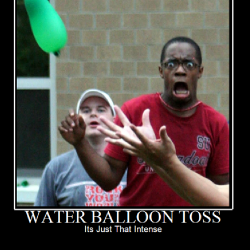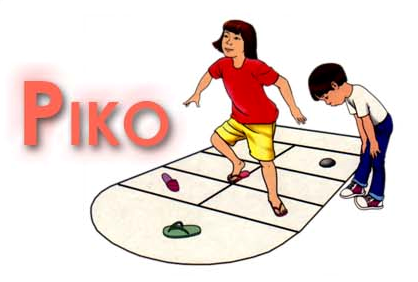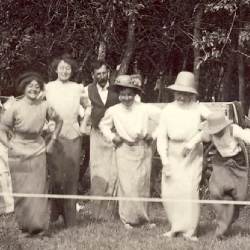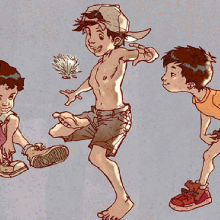3-legged race
|

|
A three-legged race involves two participants completing a race with the left leg
of one runner strapped to the right leg of another runner. The object is for the
partners to run together without falling over, and beat the other contestants to
the finish line.
|
3-on-3 Basketball
|

|
There will be a $40 registration fee this event.
Register here to enter and/or to create a team.
- Guaranteed 2 games
- Start at 2pm
- 2 courts
- 15 minute games or up to 12 pts
- All teams can be coed
- Medals presented on stage
- 1 COURT for younger kids skills and drills/free throw competition
Divisions
- 11-14u
- 15-17u
- Open
- Older 32 and up
|
Balloon Toss
|

|
A water balloon toss is a fun and sometimes messy way to entertain a crowd. This
game challenges each player's ability to throw and catch a fragile water balloon
across a long distance. Since participants run the risk of getting wet during this
game, a water balloon toss is best played outdoors in warm weather. All you need
is a few balloons filled with water and a few teams of willing participants.
|
Piko
|

|
Piko is the Philippine variation of the game hopscotch. The players stand behind
the edge of a box, and each should throw their cue ball. The first to play is determined
depending on the players' agreement (e.g. nearest to the moon, wings or chest).
Whoever succeeds in throwing the cue ball nearest to the place that they have agreed
upon will play first. The next nearest is second, and so on. The person is out for
the round if they stand with both feet.
|
Patintero
|
 Patintero, also called Harangang Taga or Tubigan (lit. try to
cross my line without letting me touch or catch you): There are two teams playing:
an attack team and a defense team; with five players for each team. The attack team
must try to run along the perpendicular lines from the home-base to the back-end,
and return without being tagged by the defense players. Patintero, also called Harangang Taga or Tubigan (lit. try to
cross my line without letting me touch or catch you): There are two teams playing:
an attack team and a defense team; with five players for each team. The attack team
must try to run along the perpendicular lines from the home-base to the back-end,
and return without being tagged by the defense players.
Members of the defense team are called it, and must stand on the water lines (also
"fire lines") with both feet each time they try to tag attacking players. The player
at the center line is called "Patotot". The perpendicular line in the middle allows
the it designated on that line to intersect the lines occupied by the it that the
parallel line intersects, thus increasing the chances of the runners to be trapped,
even only one member of a group is tagged the whole group will be the it.
Patintero is one of the most popular Filipino street games.
In 1997, Samahang Makasining (Artist Club), Inc. created time based scoring like
basketball. Each team player is compose of 6 person (4 players and 2 waiting for
replacement). The attack team will be giving 20 minutes to cross the perpendicular
lines from the home-base to the back-end and return. Each team can play for three
games. There are four horizontal water lines(also "fire lines"), two vertical lines
(left and right outside lines) and one perpendicular line in the middle of vertical
lines. Each line inside square box has a measurement of 6 meters. Only defender
person on the first lines can cross on the perpendicular line in the middle to tag
or catch the attach team.
The team can win based on highest score of one player with the most distant reaches.
Two points per line for four lines from Home-base and three points per line for
four lines from end and five points additional score for home-base player, Ex: (2
points × 4 lines) + (3 points × 4 lines) + 5 points home-base = 25 total points.
|
Potato Sack
|

|
The sack race or gunny sack race is a competitive game in which participants place
both of their legs inside a sack or pillow case that reaches their waist or neck
and hop forward from a starting point toward a finish line. The first person to
cross the finish line is the winner of the race.
Possible rule changes that people make to the traditional game include using extra
large sacks and running inside the bag; however, in some cases such activity may
be viewed as cheating.
Sack racing is traditionally seen as an activity for children, but people of any
age can compete. In schools, the sack race often takes place on a Sports Day, alongside
numerous other events such as the egg and spoon race. It is also a frequent pastime
at fairs, birthday parties, and picnics.
|
Sipa
|

|
Sipa (lit. game of Kick): The object being used to play the game is also called
sipa. It is made of a washer with colorful threads, usually plastic straw, attached
to it. Also, sipa can be played using a rattan ball or a lead washer covered in
cloth or plastic.[11] The sipa is then thrown upwards for the player toss using
their foot. The player must not allow the sipa to touch the ground by hitting it
several times with their foot, and sometimes the part just above the knee. The player
must count the number of times they was able to kick the sipa. The one with most
number of kicks wins the game. Sipa has also been the national sport of the Philippines
until 2009.[11]
The game mechanics of Sipa is similar to the Western game Hacky Sack. Sipa is also
played professionally by Filipino athletes with a woven ball, called Sepak Takraw,
with game rules borrowed from Indonesia.
|
Tug of War - FINALS
|

|
Tug of war is a sport that directly puts two teams against each other in a test
of strength: teams pull on opposite ends of a rope, with the goal being to bring
the rope a certain distance in one direction against the force of the opposing team's
pull.
|